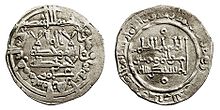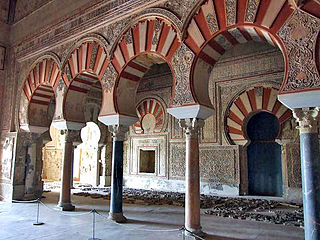Al-Hakam II
| Al-Hakam II الحکم الثاني | |||||
|---|---|---|---|---|---|
| Khalifa al-Mustanṣir bi-llah | |||||
 Statue of al-Hakam II, Córdoba | |||||
| 2nd Caliph of Córdoba | |||||
| Reign | 15 October 961 – 1 October 976 | ||||
| Predecessor | Abd-ar-Rahman III | ||||
| Successor | Hisham II | ||||
| Born | 13 January 915 Córdoba | ||||
| Died | 16 October 976 (aged 61) Córdoba | ||||
| Spouse | Subh | ||||
| Issue | Abd al-Rahman (962–970)[1] Hisham II (966–1013) | ||||
| |||||
| Dynasty | Umayyad | ||||
| Father | Abd-ar-Rahman III | ||||
| Mother | Murjan | ||||
Al-Hakam II, also known as Abū al-ʿĀṣ al-Mustanṣir bi-Llāh al-Hakam b. ʿAbd al-Raḥmān (أَبُو الْعَاصٍ الْمُسْتَنْصِرِ بِاللهِ الْحَكْمِ بْن عَبْدِ الرَّحْمَنِ; 13 January 915 – 1 October 976), was the Caliph of Córdoba. He was the second Umayyad Caliph of Córdoba in Al-Andalus, and son of Abd-al-Rahman III and Murjan. He ruled from 961 to 976.
Rule
[edit]
Al-Hakam II succeeded to the Caliphate after the death of his father Abd-ar-Rahman III in 961. He secured peace with the Catholic kingdoms of northern Iberia, and made use of the stability to develop agriculture through the construction of irrigation works. Economic development was also encouraged through the widening of streets and the building of markets.
Whilst the internal administration was left increasingly to vizir Al-Mushafi,[2] general Ghālib ibn ʿAbd al-Raḥmān was gradually gaining influence as leader of the army in North Africa. He was chiefly preoccupied with repulsing the last Norman attacks (c. 970),[3][4] and with the struggle against the Zirids and the Fatimids in northern Morocco. The Fatimids were defeated in Morocco in 974, while Al-Hakam II was able to maintain the supremacy of the caliphate over the Catholic states of Navarre, Castile and León.
Patronage
[edit]Literature and science
[edit]
Hakam himself was very well versed in numerous sciences. He had books purchased from Damascus, Baghdad, Constantinople, Cairo, Mecca, Medina, Kufa, and Basra. His status as a patron of knowledge brought him fame across the Muslim world to the point that even books written in Persia, which was under Arab Abbasid control, were dedicated to him. During his reign, a massive translation effort was undertaken, and many books were translated from Latin and Greek into Arabic. He formed a joint committee of Muwallad Muslims and Mozarab Catholics for this task.[5]
His personal library was of enormous proportions. Some accounts speak of him having more than 600,000 books. The catalogue of library books itself was claimed to be 44 volumes long.[5] Of special importance to Al-Hakam was history, and he himself wrote a history of al-Andalus.[5] Following his death, Hajib Almanzor had all "ancient science" books destroyed.[6]
The mathematician Lubna of Córdoba was employed as Al-Hakam's private secretary. She was said to be "thoroughly versed in the exact sciences; her talents were equal to the solution of the most complex geometrical and algebraic problems".[7]
The famous physician, scientist, and surgeon Abu al-Qasim al-Zahrawi (Abulcasis) was also active in Al-Hakam's court during his reign, while the leading figures of the Translation movement during the reign of Hakam were Mutazilites and Ibn Masarra.[8]
Construction
[edit]
Starting in 961, al-Hakam II initiated a major expansion of the Great Mosque of Córdoba. The mosque's prayer hall was extended 45 meters further south. This expansion added several of the building's most architecturally significant features that have survived to the present day, including a richly-decorated mihrab, intersecting multifoil arches, and four ornate ribbed domes.[9][10][11]
The palace-city of Madinat al-Zahra, first built by his father Abd ar-Rahman III after 936, continued to be built up and renovated under al-Hakam II.[12]
Personal life
[edit]Al-Hakam married Subh of Cordoba, a Basque concubine. She held sway and strong influence over the court. It is said that al-Hakam nicknamed her with the masculine name Ja'far.[13] They had two sons, the first is Abd al-Rahman (962–970),[1] who died young, and the second is Hisham II (966–1013).[14]
Possible homosexuality
[edit]According to É. Lévi-Provençal, the phrase Ḥubb al-walad, as found in al-Maqqari's Nafḥ al-ṭayyib,[15] is a reference to al-Hakam's homosexuality or "preference for boys".[16][17] However, several historians render it as "paternal love", referring instead to him choosing his young son as a successor.[18][19][20] The fact that he did not produce a suitable heir before the age of 46 has been ascribed either to him being more attracted to men,[21]—although this is only reported euphemistically in the sources,[17]—or because he was too absorbed with his books to care for sensual pleasures.[13] Subh may have dressed as a ghulam or a young man to make herself more attractive to al-Hakam (adopting a short haircut and wearing trousers), although it is also possible she did this in order to gain better access to the male-dominated royal court.[22]
Death and succession
[edit]Al-Hakam II suffered a stroke near the end of his life that curtailed his activities and may explain why he was unable to properly prepare his son for leadership.[23] Modern scholars have speculated that, based on the historical descriptions of his death, it was another cerebrovascular stroke, possibly brought on by the cold weather, that claimed his life in October 976.[24] He was succeeded by his son, Hisham II al-Mu'ayad, who was 11 years old at the time and during his minority under regency by General Ghalib al-Nasiri, al-Mushafi, chief administrator of the late caliph, and Subh, his mother, assisted by her secretary Almanzor.[25]
See also
[edit]References
[edit]- ^ a b Prado-Vilar 1997, p. 23.
- ^ Bariani, Laura (2003). Almanzor (in Spanish). Editorial NEREA. p. 66. ISBN 9788489569850.[permanent dead link]
- ^ Brill, E. J. (1993). E. J. Brill's First Encyclopaedia of Islam 1913 - 1936 Volume III. BRILL. p. 223. ISBN 9004097899.
- ^ Scheen, Rolf (1996). "Vikings raids on the Spanish Peninsula". Militaria. Revista de culturea militar (8). Complutense University of Madrid: 67. Retrieved 2018-10-05.
- ^ a b c Najeebabadi, Akbar (2001). The History of Islam V.3. Riyadh: Darussalam. p. 145. ISBN 978-9960-892-93-1.
- ^ Ann Christy, Christians in Al-Andalus:711-1000, (Curzon Press, 2002), 142.
- ^ Scott, Samuel Parsons (1904). History of the Moorish Empire in Europe Vol. 3. Lippincott. p. 447.
- ^ Samsó, Julio; Fierro, Maribel (23 October 2019). The Formation of al-Andalus, Part 2: Language, Religion, Culture and the Sciences. Routledge. ISBN 9781351889575.
- ^ Barrucand, Marianne; Bednorz, Achim (1992). Moorish architecture in Andalusia. Taschen. pp. 73–85. ISBN 3822896322.
- ^ Dodds, Jerrilynn D. (1992). "The Great Mosque of Córdoba". In Dodds, Jerrilynn D. (ed.). Al-Andalus: The Art of Islamic Spain. New York: The Metropolitan Museum of Art. pp. 18–23. ISBN 0870996371.
- ^ Bloom, Jonathan M. (2020). Architecture of the Islamic West: North Africa and the Iberian Peninsula, 700-1800. Yale University Press. pp. 69–77. ISBN 9780300218701.
- ^ Vallejo Triano, Antonio (2007). "Madinat Al-Zahra; Transformation of a Caliphal City". In Anderson, Glaire D.; Rosser-Owen, Mariam (eds.). Revisiting al-Andalus: perspectives on the material culture of Islamic Iberia and beyond. Brill. pp. 3–26. ISBN 978-90-04-16227-3.
- ^ a b Ruggles, D. Fairchild (2004). "Mothers of a hybrid dynasty: Race, genealogy, and acculturation in al-Andalus". Journal of Medieval and Early Modern Studies. 34 (1): 73. doi:10.1215/10829636-34-1-65. S2CID 170890527.
- ^ Christys, Ann Rosemary (2013-01-11). Christians in Al-Andalus 711-1000. Routledge. p. 106. ISBN 978-1-136-12730-4.
- ^ Al-Makkari, Analectes sur l'histoire et la littérature des Arabes d'Espagne, vol.2, p.59)
- ^ Lévi-Provençal, Evariste (1957). España musulmana hasta la caída del Califato de Córdoba (711-1031 de J.C.). Espasa-Calpe. pp. 447–8.
Hay, indudablemente, algo de verdad en la alusién que un cronista musulmán (apud Maqqari, Analectes, II, 59) hace a la «paidofilias» (hubb al-walad) de al-Hakam II, antes de su accesién al trono. En todo caso es evidente que sólo después de su adveni- miento fué cuando se preocupó de tener un hijo susceptible de sucederle. ¿Habrá que creer, según el mismo cronista, que fué la practica de este vicio, tan corriente en la España musulmana en todas las épocas, el que occasionó la paternidad tan tardía de al-Hakam II? Véase, sin embargo, Ibn Hazm, Tawg al-hamama, pág. 6, a propósito de la pasión que sentía el califa por su concubina Subh.
- ^ a b Prado-Vilar, Francisco (1997). "Circular visions of fertility and punishment: caliphal ivory caskets from al-Andalus". Muqarnas. 14: 19–41. doi:10.1163/22118993-90000368. JSTOR 1523234.
- ^ De Gayangos, Pascual (1843). The History Of The Mohammedan Dynasties In Spain Vol II. By W.H.Allen And Company. pp. 176-7.
Ibn Bessam, copying Ibn Hayyan, says, "Among other virtues Al-hakem possessed that of paternal love in such a degree that it blinded his prudence and induced him to appoint a son of his, who was then a child, to be his successor, in preference to any of his brothers or nephews, all men of mature age, well versed in the management of affairs and in the command of the armies, capable of making their mandates obeyed, and of maintaining themselves in power.
- ^ al-Wasif, M. F. (2012). "Mustansir, al-Hakam". Biblioteca de al-Andalus. Vol. 7. Árabes Fundación Ibn Tufayl de Estudios Árabes. p. 591. ISBN 978-84-934026-0-0.
Cabe señalar, por último, que sería bastante difícil dar credibilidad a la cuestión de la "paidofilia" de al-Hakam II en un pasaje de Ibn Hayyān tomado por al-Maqqarī -y viene más claro en el Dajīra-, en el cual figura ḥubb al-walad en el contexto de una crítica de Ibn Ḥayyān dirigida a al-Ḥakam II por haberse dejado llevar por el amor al hijo (ḥubb al-walad) que le impulsó a nombrar y tomar juramento de fidelidad a su hijo menor en calidad de presunto heredero del califato, acto que tuvo lugar el 1 de Jumāda II del 365 (=5 febrero 975) en el Alcázar de Córdoba, La misma crítica basada en dicho argumento, la hace también Ibn al-Jaṭīb en sus Aʿmāl. Y no vamos a insistir in la evidencia de que el término waled significa "hijo", empleado en muchas ocasiones en los textos andalusíes para referirse a un infante Omeya, y no "efebo/s" (gulam/gilmān), y éste precedido por "hubb" indicaría lo que se ha dicho antes.
- ^ García-Sanjuán, Alejandro (2008). "Legalidad islámica y legitimidad política en el califato de Córdoba: la proclamación de Hisham II (360-66/971-76)". Al-Qantara XXIX-1 (2008). 29 (1): 70.
Ibn Hayyan, quien no duda en condenar la actuación de al-Hakam sobre su sucesión, acusándolo de haberse dejado llevar en exceso por el amor hacia el hijo (kāna mimman istahwā-hu ḥubb al-walad wa-afraṭa fī-hī) y descartando así como heredero a algún adulto, bien fuese alguno de sus hermanos u otro miembro del linaje Omeya que pudiese haber desempeñado el imamato «sin favoritismos» (bi-lā muḥābā).
- ^ Évariste Lévi-Provençal, Histoire de l'Espagne musulmane, Paris, 1950
- ^ Ibtissam Bouachrine, Women and Islam, Lexington Books, 2014, pp. 5, 22
- ^ Al-Hakam II, Caliph of Cordoba, Marilyn Higbee Walker, Encyclopedia of Medieval Iberia, ed. Michael Gerli (New York: Routledge, 2003), 377.
- ^ Arjona-Castro, A. (February 1997). "Cerebrovascular stroke, the cause of the death of the caliph al-Hakam II". Neurologia. 12 (2): 78–81. PMID 9147455.
- ^ Mernissi, Fatima; Mary Jo Lakeland (2003). The forgotten queens of Islam. Oxford University Press. ISBN 978-0-19-579868-5.
External links
[edit]- Arabic biography
- Stirnet: Iberia04 (subscription required)

